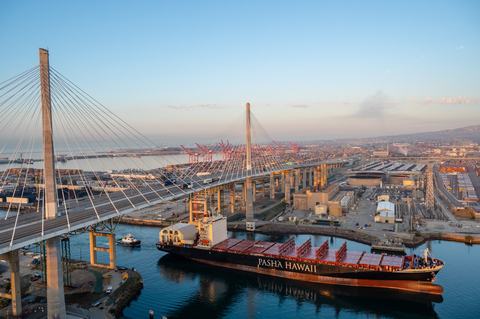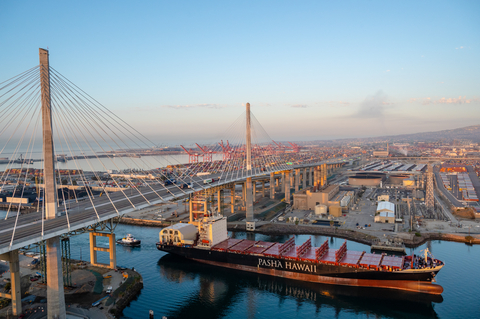NEWPORT BEACH, Calif.--(BUSINESS WIRE)--Clean Energy Fuels Corp. (NASDAQ: CLNE), the largest provider of the cleanest fuel for the transportation market, supplied fuel for the first bunkering with liquified natural gas (LNG) of Pasha Hawaii’s new container ship MV George III. This was the first LNG bunkering of a container ship on the U.S. West Coast. Clean Energy worked with World Fuel Services and West Coast Clean Fuels to supply the ship with over 300,000 gallons of the clean fuel.
Pasha Hawaii’s MV George III, a 774-foot container ship operating between Long Beach, CA, Honolulu, HI, and Oakland, CA, is the first of three LNG-powered ships that the domestic shipping company is putting into service. The three ships are expected to consume 105 million gallons of LNG fuel over the next five years.
“The air quality around the Ports of Long Beach and Los Angeles is some of the worst in the country because of in large part the very dirty marine fuels that have been traditionally used by container ships,” said Andrew J. Littlefair, president and CEO, Clean Energy. “The move by Pasha to add ships that operate on clean-burning LNG is one the most forward-thinking and environmentally-progressive actions taken in the maritime industry. We congratulate Pasha on their first successful bunkering operation and look forward to many more as Pasha continues to add the other LNG-powered ships to their fleet.”
LNG-powered ships achieve 99.9 percent reduction in diesel particulate matter and sulfur oxide emissions, 90 percent less nitrogen oxides and a 25 percent reduction in carbon dioxide compared to ships running on traditional fuels.
The LNG that powers the Pasha Hawaii container ships is supplied by the Clean Energy plant in Boron, CA, the only one of its kind in the state. Because of the increase in demand for LNG by Pasha and others, Clean Energy is in the process of expanding its Boron LNG plant by adding a third production train, which will increase capacity by 50 percent when completed.
The MV George III is scheduled to bunker every second week at the Port of Long Beach. The second Pasha ship to operate on LNG, the Janet Marie, is expected in late 2022. The third Pasha ship is expected to be deployed in mid-2023.
Before the MV George III arrived at the Port of Long Beach, Clean Energy supported Pasha in the commissioning of the ship. Clean Energy worked at the shipyard in Brownsville Texas to cool down the ship’s LNG storage tank to cryogenic temperature and then performed two bunkering operations to load LNG into the ship tanks. The LNG was provided from Clean Energy’s Pickens LNG Plant in Texas.
About Clean Energy
Clean Energy Fuels Corp. is the country’s largest provider of the cleanest fuel for the transportation market. Our mission is to decarbonize transportation through the development and delivery of renewable natural gas (RNG), a sustainable fuel derived from organic waste. Clean Energy allows thousands of vehicles, from airport shuttles to city buses to waste and heavy-duty trucks, to reduce their amount of climate-harming greenhouse gas. We operate a vast network of fueling stations across the U.S. and Canada. Visit www.cleanenergyfuels.com and follow @ce_renewables on Twitter.
Forward-Looking Statements
This news release contains forward-looking statements within the meaning of Section 27A of the Securities Act of 1933 and Section 21E of the Securities Exchange Act of 1934 that involve risks, uncertainties and assumptions, including without limitation statements about the operations of the MV George III and other Pasha Hawaii container ships, the amount of LNG to be consumed, the environmental benefits of containerships operating on natural gas, and expansion of the Boron LNG plant. Actual results and the timing of events could differ materially from those anticipated in these forward-looking statements. The forward-looking statements made herein speak only as of the date of this press release and, unless otherwise required by law, Clean Energy undertakes no obligation to publicly update such forward-looking statements to reflect subsequent events or circumstances. Additionally, the reports and other documents Clean Energy files with the SEC (available at www.sec.gov) contain risk factors, which may cause actual results to differ materially from the forward-looking statements contained in this news release.




